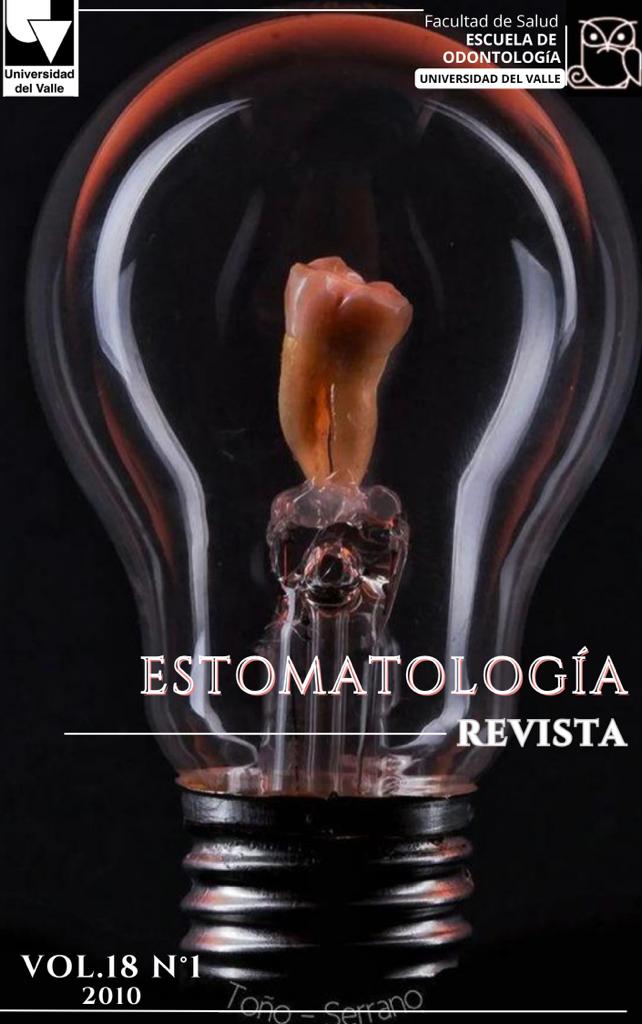Dental anomalies in patients attending private practice and institutions in the city of Cali 2009-2010
Main Article Content
Objectives: To identify dental anomalies in patients who attended a private and an institutional dental practice from September, 2009 to January, 2010.
Materials and methods: A descriptive study was made with 525 patients who attended the dental practice. There were found and classified 115 dental anomalies, corresponding to 21.9% of cases.
Results: There were found 115 cases in patients from 5 to 27 years of age, 63% of male and 37% female. The most common dental anomalies corresponded to position anomalies, with 39 cases (34%) followed by the abnormalities in number presented in 19 cases (16.5%). Anomalies of structure and color were 12.1% and the less common were root anomalies present in 6.9% of cases.
Conclusions: The dental anomalies of any kind are common in dental patients, so is important to make a correct diagnose of patients attending a dental clinic, to record the findings on the clinical history and to implement treatment plans to improve function, aesthetics, comfort and self-esteem.
- Anomalies of the root
- position
- number
- structure
- color
2. Van Waes HJM, Söckli PW. Atlas de odontología Pediátrica. Primera Edición. Masson S.A. Barcelona: 2002. 61-100.
3. Bordóni N., Escobar A., Castillo R., Odontologia Pediátrica. La salud Bucal del Niño y adolescente en el mundo actual. Ed Medica Panamericana; 2010. 549-584.
4. Mursuli M, Rodríguez H, Landa L, Hernández M, Anomalías dentales Gaceta Medica Espirituana 2006; 8(1)
5. Mc. Donald R, Avery D.Ausencia congénita de dientes (Odontología pediátrica y del adolescente). Séptima Edición. Editorial Mosby Doyma Libros: Madrid España; 1995.
7. Morales U, Pompa y Padilla JA. Anomalías dentales de desarrollo asociadas a la colección prehispanica. Rev ADM 2003; 60(6):219 224.
8. Schulze C. Anomalías en el desarrollo de los dientes y maxilares. En: Gorlin RJ, Goldman HM. Patología Oral. Barcelona: Salvat Editores SA; 1984. 105-202.
9. Bastidas AM, Rodriguez AM. Agenesia dental en pacientes jóvenes. Revista Estomatologia 2004; 12(2):34-43.
10. Trevor J. Pemberton JG, Pragna IP. Gene discovery for anomalies: A Primer for the dental professional. J Am Dent Assoc 2006; 137:743-752.
11. Chung CS. Niswander DW, Runck SE, Kau MCW. Genetic and Epidemiologic Studies of Oral Characteristics in Hawai’s School Children: Dental Anomalies. Am J Physical Anthrop 1972; 3: 427- 436.
12. Winkler MP. Ahmad R. Multirooted anomalies in the primary dentition of Native Americans. J Am Dent Assoc 1997; 128:1009-1011.
13. Kramer P.F.,Feldens CA, Ferreira S H, Hermann M, Gerson E., Dental anomalies and associated factors in 2-to 5 year –old Brazilian children,. International J of Paediatric Dentistry 2008; 18:434-440.
14. Takashi O, Ryosuke I, Kenro M,Shizuo S. The Prevalence of developmental anomalies of teeth and their association with tooth size in the primary and permanent dentitions of 1650 Japanese children International J of Paediatric Dentistry 1996; 6:87-94
15 O’Sullivan E. Multiple dental anomalies in a young patient:a case report International J of Paediatric Dentistry 2000; 10:63-66.
16. Duque AM, Escobar S. Anomalias dentarias de Numero, Agenesia, Hipodoncia y Oligodoncia. Revista Estomatología 2002; 1:32-38.
17. Cho SY. Supernumerary Premolars associated with den evaginatus: Repot of 2 Cases J. of Canadian Dental Association 2005; 71(6):390-293.
18. Hernandez J. Coexistencia de ausencia congenita y dientes supernumerarios. Reporte de dos casos Clinicos. Revista Estomatología 2000; 9:68-71.
19. Cho S. Y. Dental Absccess in a tooth with intact den evaginatus .I J of paediatric Denttistry 2006; 16:135-138.
20. Crincoli V. Di Bisceglie MB,Scivetti M, Favia A, Di Comite M. Dens in vaginatus:a qualite-quantitave analiysis.Case report of an upper second molar. Ultrastruc Pathol 2010; 34 (1):7-15.
21. Saini T, Ogunleye A, Levering N, Norton NS, Edwards P. Multiple enamel pearls intwo siblings detected by volumetr computed tomography .Dentomaxillofac Radiol 2008; 37(4):240-244.
22. BarberiaE, Boj JR, Montserrat C, Garcia C, Mendoza A, Odontopediatria. Segunda Edicion. Editorial Masson: España; 2001. 85-113.
23. Hashem AA,O’Connell B, Nunn J, O’Connell A, Garvey T, O’sullivan.M. Tooth agenesis in patients to an Irish tertiary care clinic for the developmental dental disorders. J Ir Dent assoc 2010; 56 (1):23-27.
24. Taguchi Y, Hayashi S, Iizawa F et al. Clasification of maxillary canine transpositions in Japanese children: A report of 10 cases J Pediatrc dental 2009; 19(1):136-144.
25. Akcam MO, Evirgen S, Uslu O, Mermikoglu U. Dental anomañies in individuals with cleft and /or palate. European J of Orthodontics 2010; 32:207 213.
26. Camilleri S. Double transmigration and hyperdontia J Angle Orthodontis 2007; 77(4).
27. Kansu O, Avcu N. Mandibular lateral incisor-Canine transposition Associated with Dental anomalies, Clinical Anatomy 2005; 18:446-448.
Downloads
Los autores/as conservan los derechos de autor y ceden a la revista el derecho de la primera publicación, con el trabajo registrado con la licencia de atribución de Creative Commons, que permite a terceros utilizar lo publicado siempre que mencionen la autoría del trabajo y a la primera publicación en esta revista.





